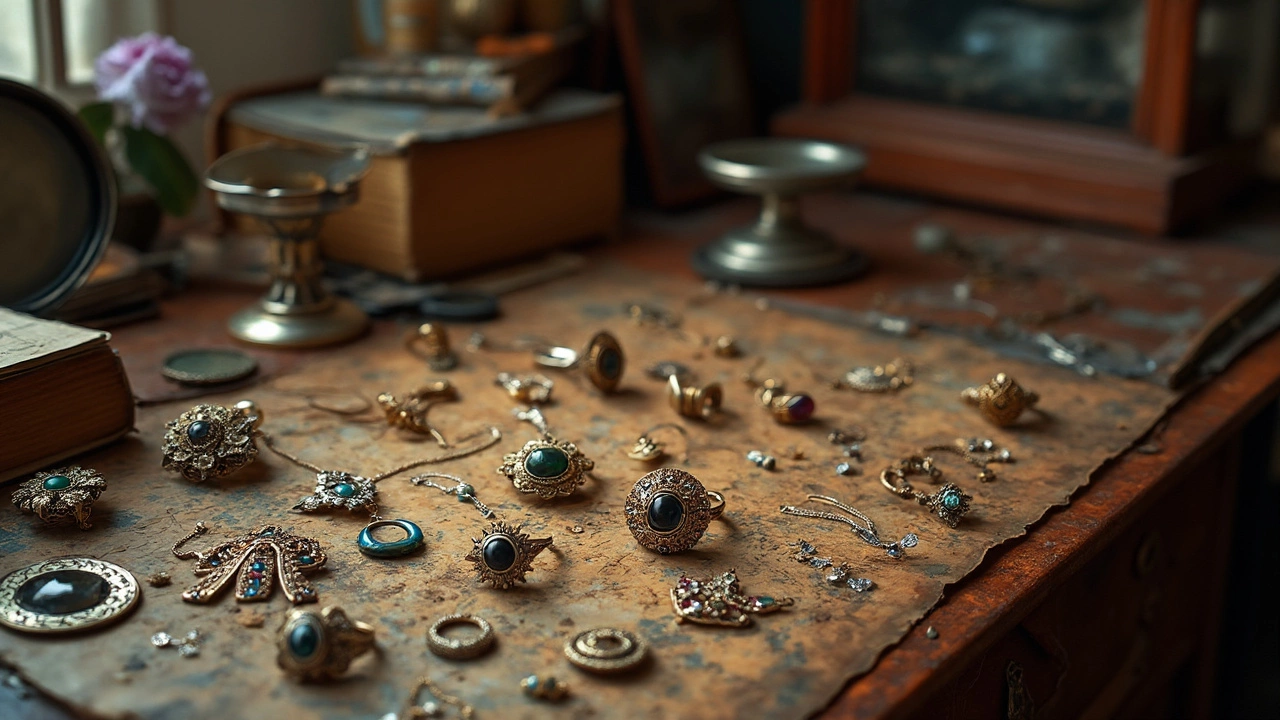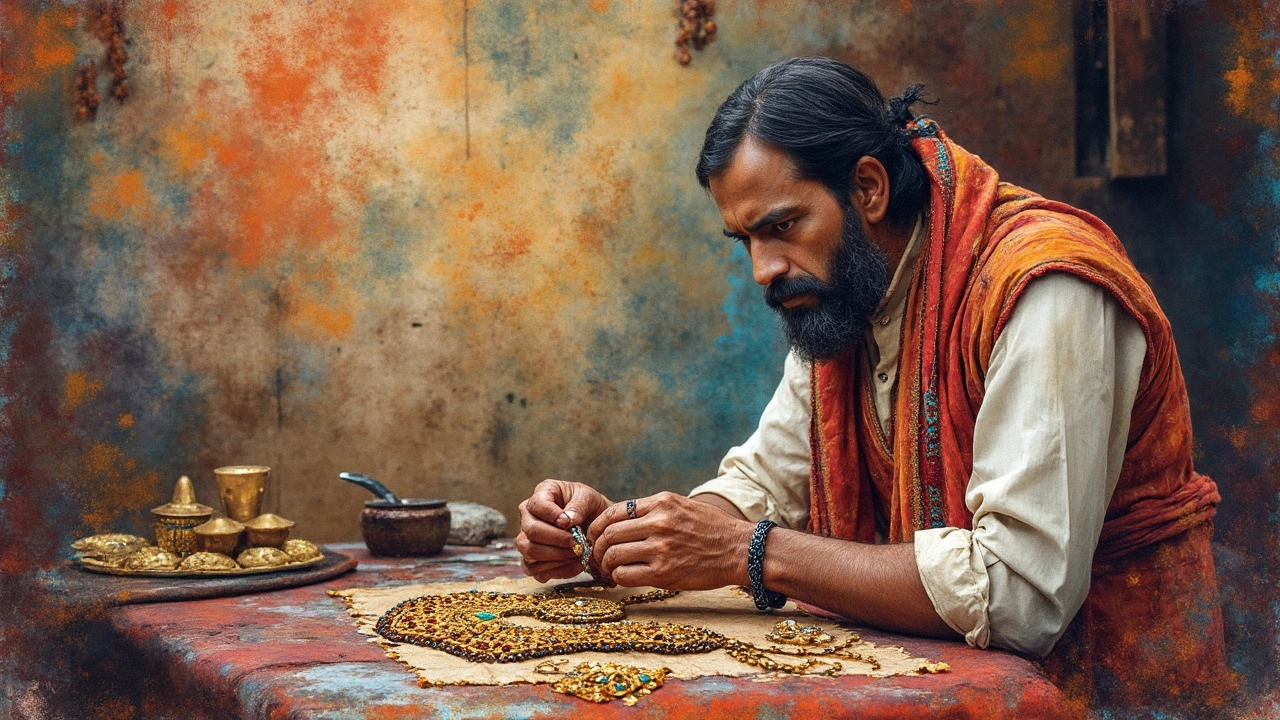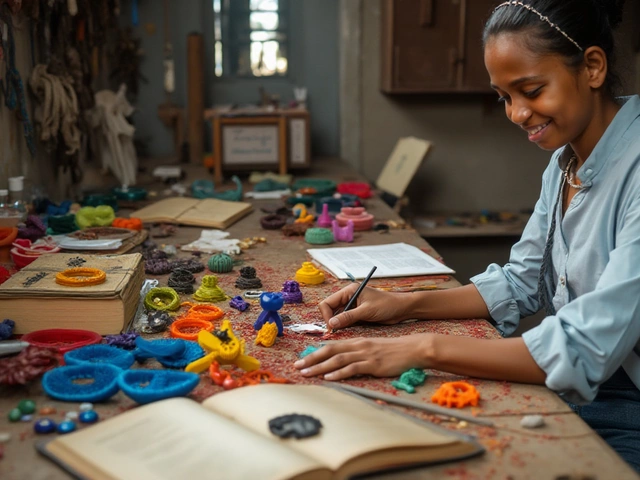
Ever found yourself staring at that old necklace your grandma left you, wondering if it's worth more than just sentimental value? You're not alone. Many of us have bits of jewelry and heirlooms tucked away, with dreams they might be hiding a hefty price tag. The good news is, with some know-how, you can start figuring it out.
First, have a look at the design. Antique jewelry often boasts unique styles that scream 'I'm from another era!' These details can give you clues about when and where the piece was made. Look at the overall design motif; is it leaning toward floral Victorian or Deco geometric? These styles aren't just pretty—they can point to a specific time in history when such designs were all the rage.
- Recognizing Unique Designs
- Materials and Craftsmanship
- Historical Context
- Getting a Professional Appraisal
Recognizing Unique Designs
When it comes to antique jewelry, the design is king—or queen, depending on your style. Spotting these unique designs is often your first clue to identifying something valuable. Think of it like recognizing a famous painting by the brushstrokes or style. Each era has its own distinctive flair!
Let's break it down a bit. In the Victorian era (1837-1901), jewelry often had intricate floral patterns and symbolism. It was all about the detail back then. Hop over to the Art Deco period (1920s-1930s), and you'll see bold geometric shapes and vibrant colors. This was the time of jazz and modernism, and it showed in the bling!
Keep an eye out for these design cues:
- Victorian Jewelry: Look for pieces with motifs of flowers, hearts, and bows. Mourning jewelry, often made with jet or featuring locks of hair, also pops up from this era.
- Art Nouveau (1890-1910): Dreamy, flowing lines and natural themes like flowers and insects rule here. Think of it as jewelry that's a bit romantic and whimsical.
- Art Deco: Made for the glam crowd, look for bold lines, geometric patterns, and often a mix of vibrant stones.
- Mid-Century Modern (1940-1960): Think clean, sleek lines, often with a space-age influence. Less is more during this time.
Recognizing these styles requires a bit of historical detective work, but it's fascinating once you get the hang of it. And who knows, you might find out that your grandma's old brooch isn't just pretty—it's valuable!
Above all, pay attention to the craftsmanship. Handmade pieces, which have minor inconsistencies because of the hands-on work, often indicate an older era, adding to their charm and, sometimes, their worth.
Materials and Craftsmanship
Alright, let's dive into what makes antique jewelry not just look fancy, but actually valuable. One of the main things to consider is the materials. Back in the day, artisans didn’t have easy access to modern tools, so they relied on high-quality materials to stand out.
If you've got a piece featuring gemstones, you're in luck if they’re genuine. Check for natural imperfections—real stones are rarely flawless. Those bright colored stones like emeralds and sapphires were favorites. Don’t be shy about getting a jeweler’s loupe to have a closer look. It's like a spyglass for your jewelry!
Then there’s the metal. Precious metals like gold, silver, and platinum used to be the gold standard—no pun intended. A quick tip: the more carats, the more valuable the gold. And keep your eyes peeled for hallmarks or stamps that might indicate where and when it was made. These little engravings are like the fingerprints of your piece and can significantly up the value.
The craftsmanship is another biggie. Handmade pieces usually carry an air of uniqueness. If your item shows signs of being crafted by hand – like small discrepancies or intricate detailing that's not uniform, that might mean you've got something special. Back then, jewelry was about showing off the maker's skills, so people put tons of effort into the finishing touches.
Antique pieces often come from times when great attention was paid to detail and durability, unlike some mass-produced pieces today. So if you've got something that feels rigid and solid, take note—it might be crafted with care from days gone by.
Lastly, here's a pro tip: try out a simple magnet test. Most valuable metals aren't magnetic, so if your jewelry leaps to a magnet, it might not be what you hoped. Just a quick hack to add to your sleuthing toolkit!

Historical Context
Diving into the history of your piece is like unraveling a story that spans generations. Antique jewelry is often a reflection of the era it was made in, shaped not just by fashion but also by the social and economic tides of its time. Getting a grip on this context can be the key to unlocking its value.
Think about the Georgian era (1714-1837) for instance, when jewelry was handmade and often featured intricate metalwork with precious stones like diamonds and emeralds. Pieces from this time are quite rare because much jewelry was melted down and reused as styles changed. If your ring or necklace seems fit for a period drama, it could be Georgian.
Moving on to the Victorian era (1837-1901), there was a shift towards more mass-produced items due to the Industrial Revolution. The use of materials like gold was prominent, and pieces often carried sentimental designs—think heart lockets and mourning jewelry. Items from this period might have been passed down in families, adding layers of sentimental and historical value.
The Art Deco period (1920-1939) reflected the exuberance of the Roaring Twenties, showcasing bold geometric designs and the use of vibrant stones like sapphires and rubies. If your piece resembles something Gatsby might wear, it could indeed be from this vibrant era.
Understanding the historical backdrop not only adds to the charm of your vintage designs but also helps you appreciate their potential worth. By correlating design elements and craftsmanship with specific periods, you're better equipped to determine the significance of your jewelry in historical terms—and its desirability in today’s market.
Here’s a simple way to track what era your piece might be from:
- If it's intricate with lots of metalwork and minimal stones, think Georgian.
- Does it feature red or black stones and romantic motifs? Consider Victorian.
- Bright, loud, and geometric? Likely Art Deco.
Getting a Professional Appraisal
So, you've given your jewelry a once-over, and now you're thinking, 'Is this antique jewelry worth getting a professional to take a look?' Absolutely. A seasoned appraiser can make a world of difference. They'll assess aspects you might not even think about, and they know the market inside out.
Look for appraisers with proper credentials and experience in valuing vintage designs. The American Society of Appraisers (ASA) and the National Association of Jewelry Appraisers (NAJA) are solid places to start if you're hunting for pros. A good appraiser will have a strong background, usually with certifications that back up their expertise.
Here's how the appraisal process generally works:
- First, you'll need to book an appointment. Some appraisers might do it in person, while others can offer virtual consultations. If they do see you face-to-face, they'll inspect every nook and cranny of your piece.
- They’ll examine materials, craftsmanship, and any hallmarks or stamps, often armed with a magnifying glass and other tools of the trade.
- The appraiser will provide a detailed report outlining the current market value of your valuable jewelry. This can be super useful if you're planning to sell, insure, or just want a clearer picture of what you own.
Keep in mind, the value set by an appraiser isn't an exact sale price. It’s more of an estimate based on market trends and historical data. Appraisals can also vary in pricing, depending on the complexity of your piece. Pricing might be hourly or a flat rate, so it’s wise to discuss fees upfront.
With these insights, you're in a much better position to decide what to do next. Whether you’re selling, insuring, or simply satisfying your curiosity, a professional appraisal is a smart move.


